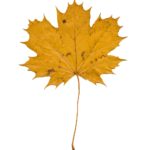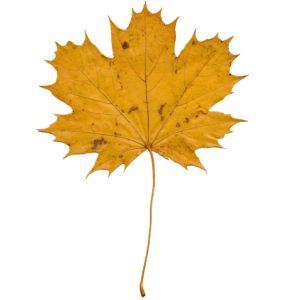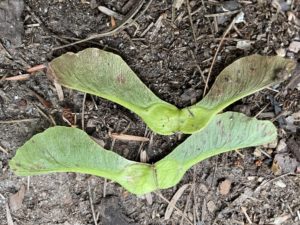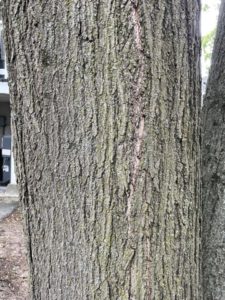
By Jeffrey North
Invasive plant species are disrupting ecosystems from Belmont to Beijing, permanently altering the ecology of our forests, fields, and gardens and causing biodiversity loss and species extinction. This article is the fourth in a series on invasive plant species found in Belmont, the implications of their presence, spread, ecological damage potential, and hopes for their removal and remediation.
Acer platanoides, commonly known as the Norway maple, is a species of maple native to eastern and central Europe and western Asia. It was brought to North America in the mid-1700s as a shade tree.
The Norway maple is a large deciduous tree that can grow to 60 feet or more in height. As a lone tree, it can be magnificent. But these trees have very shallow roots and produce a great deal of shade which makes it difficult for grass and other plants to grow in the understory. This species can crowd out most others, including grasses, understory plants, and other tree species right up to the edge of its canopy.
Norway maples’ fall foliage is arguably pale and anemic compared with native maples. A Norway maple’s leaves turn a rich yellow in the fall under optimal conditions, but lack the brilliant reds and oranges that emblazon our Northeast forests and towns.
Norway maples grow faster than native maples and other forest trees and tolerate diverse environments. Seed production is prolific, and seeds are hardy and invasive. They are prone to sprout in the middle of existing ornamental gardens and hedges even as the species invades our forests and forest edges.
History
The Norway maple was introduced to the American colonies in 1756 by John Bartram of Philadelphia, a self-educated naturalist and explorer considered the “father of American botany” and a friend of Benjamin Franklin. The seedlings and saplings were soon widely planted on farms and in towns for their shade, hardiness, and adaptability.
Since Colonial days, Norway maples have spread throughout the northeastern United States from Maine to Wisconsin, south to Tennessee and Virginia, and west to the Pacific. With reforestation across the Northeast since the mid-nineteenth century, Norway maples have escaped from in-town plantings to our forests.
Identification
Norway maples are sometimes confused with our native sugar maple (Acer saccharum). Here are a few distinguishing characteristics that can be used to tell the two apart.
- The leaf of the sugar maple features three wide lobes (or main points) each with a few irregular wavy teeth, plus two one-point lobes near the stem. The bigger Norway maple leaf, by comparison, sports seven lobes.
- Norway maple trees ooze a milky white sap from their stems when you snap off a leaf. Sugar maple leaves have clear, watery sap.
- Norway maple leaves are usually broader than they are long, while sugar maple leaves are generally longer than wide.
- Norway maple seeds form in oppositely arranged pairs with a wide 180° spread; sugar maple seeds and other native maple seeds are horseshoe-shaped where the wings droop at a 45° to 90° angle.
- Norway maple terminal buds are large, rounded, and blunt, with only two or three pairs of scales; sugar maple buds are long and sharply pointed with many scales.
- The bark of mature Norway maples has tight, furrowed grooves, similar to our native ash, while sugar maple bark is both flattish and smooth when young or plated when older.
- Norway maple leaves are very distinguishable in the fall. They keep their leaves after most native plants have dropped them. Their leaves also turn a pale to orange-yellow in contrast to sugar maple’s brilliant oranges and reds.
The Problem
The Norway maple thrives in urban environments due to a high tolerance for concrete, compacted soils, salt, and automobile exhaust. But the Norway maple is a bully. It beats up on biodiversity as it conquers ecosystems by developing impenetrable monocultures. Monocultures are inherently unstable. Sugar maples, meanwhile, play well with others. They thrive in mixed, biodiverse, healthy forests.
Norway maples are suspected of releasing chemicals from their roots that inhibit or prevent other plants from growing nearby, thus eliminating competition for water, nutrients, and light. Norway maples are also thirsty plants, absorbing much more water than other trees. Reduced groundcovers lead to erosion and loss of soil, which in turn lead to lower water quality in surface waters and wetlands. Furthermore, Norway maples are less susceptible to local diseases and pest insects than our native sugar maples, which gives them a competitive advantage.
Town planners once favored the Norway maples in part because caterpillars shun their waxy leaves. That is appealing to every gardener who wants to keep bugs at bay. But if trees are free of bugs, birds find little to eat, so they leave the neighborhood.
Consider the fate of chickadees, as detailed by Doug Tallamy, a professor of entomology at the University of Delaware’s College of Agriculture and Natural Resources and the author of Bringing Nature Home. According to Tallamy, chickadee nestlings generally eat at least 6,000 caterpillars, all foraged within 50 meters of their nest, before they fledge.
When Norway maples take over an area, few caterpillars survive, reducing the food available for little chickadees. The chickadees produce fewer young or do not reproduce at all.
The Solution
Mowing or hand-pulling Norway maple seedlings and small saplings can be effective. Mature trees will re-sprout from the stump if not treated with a systemic herbicide. Girdling (removing tissue around the circumference) of mature trees may be effective, especially when girdles are treated with herbicide, but in most cases, mature trees are best left alone or removed by tree professionals.
Belmont’s streets need all the shade trees they can get, including Norway maples. However, when trees are removed due to storm damage or disease (an increasingly frequent occurrence in Belmont), replacing them with native trees that have value for wildlife is the best practice. Street trees in Belmont are replaced these days with sycamore, linden, red maple, and London plane trees (admittedly a small diversity range) by our Department of Public Works. You can find a list of recommended trees at the Massachusetts Department of Conservation and Recreation’s Urban and Community Forest Program.
If people express horror about cutting down a tree, use it as an opportunity to tell them about the value of planting native species that increase ecological value while combating the evils of non-native, invasive species. Alternately, you might suggest they write a letter to the editor of this publication.
Jeffrey North is the ex officio Belmont Conservation Commission representative on the Land Management Committee for Lone Tree Hill and managing editor of the Belmont Citizens Forum Newsletter.





Sorry, the comment form is closed at this time.